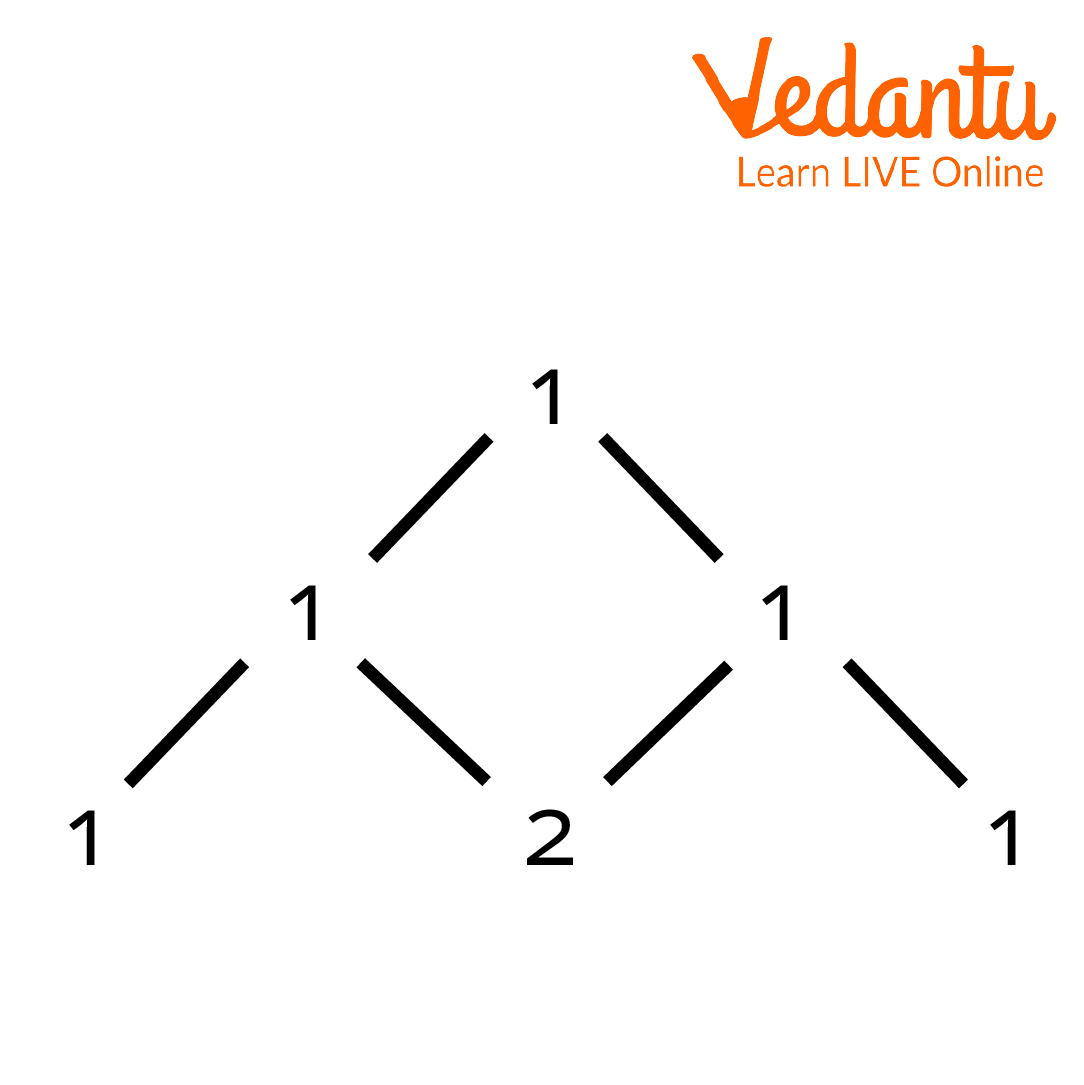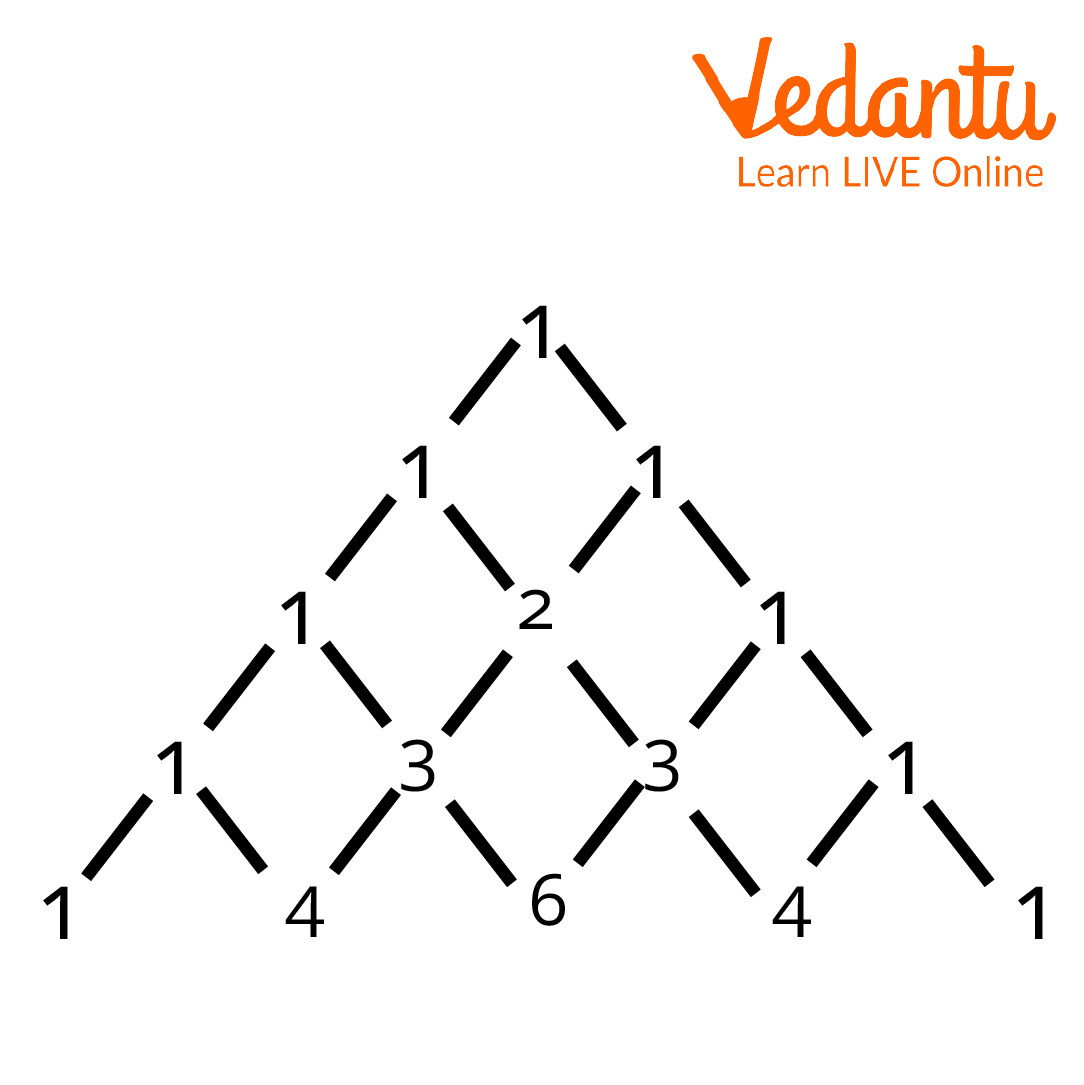




Step-by-Step Guide to Using Pascal’s Triangle in Binomial Expansion
Pascal's triangle is a triangular array of binomial coefficients found in probability theory, combinatorics, and algebra. Pascal’s triangle binomial theorem helps us to calculate the expansion of ${{(a+b)}^{n}}$, which is very difficult to calculate otherwise. Pascal's Triangle is used in a variety of fields, including architecture, graphic design, banking, and mapping.
History of Blaise Pascal

Blaise Pascal
Born: 19th June 1623
Died: 19th August 1662
Nationality: French
Contribution: He gave Pascal's Triangle Binomial Theorem to the world.
Statement of the Pascal's Triangle Binomial Theorem
The Pascal’s Triangle Binomial Theorem states that the formula to find the entry of an element in the ${{n}^{th}}$ row and ${{k}^{th}}$ column of a Pascal’s Triangle is given by
$\left( \begin{array}{*{35}{l}}n \\k \\\end{array} \right)$
The formula listed below can be used to determine the components of the following rows and columns:
$\left( \begin{array}{*{35}{l}} n \\k \\\end{array} \right)=\left( \begin{array}{*{35}{l}} n-1 \\k-1 \\\end{array} \right)+\left( \begin{matrix}n-1 \\k \\\end{matrix} \right)$
Proof of the Pascal's Triangle Binomial Theorem
Assuming\[k\le n\],
$\left( \begin{matrix}n-1 \\k-1 \\\end{matrix} \right)+\left( \begin{matrix}n-1 \\k \\\end{matrix} \right)=\frac{(n-1)!}{(k-1)!(n-k)!}+\frac{(n-1)!}{k!(n-k-1)!}$
$=(n-1)!\left( \frac{k}{k!(n-k)!}+\frac{n-k}{k!(n-k)!} \right)$
$=(n-1)!\cdot \frac{n}{k!(n-k)!}$
$=\frac{n!}{k!(n-k)!}$
$=\left( \begin{array}{*{35}{l}} n \\k \\\end{array} \right)$
Hence proved.
Application of the Pascal's Triangle Binomial Theorem
We can write big binomial expansions with the help of Pascal’s triangle and we won’t have to use the formulas for binomial expansion.
Concepts of Pascal’s Triangle are also used in so many Maths puzzles.
Limitations of the Theorem
For positive integral exponents, the theorem can’t be applied to commutative algebra.
For negative or fractional exponents, the corresponding infinite series are subject to convergence criteria.
Solved Examples
1. Expand and verify ${{\left( a+b \right)}^{2}}$.
Ans:

Pascal’s Triangle
First, let’s write the generic equation without the coefficients:
${{(a+b)}^{2}}={{c}_{0}}{{a}^{2}}{{b}^{0}}+{{c}_{1}}{{a}^{1}}{{b}^{1}}+{{c}_{2}}{{a}^{0}}{{b}^{2}}$
The last row of the triangle gives us the value of coefficients:
${{c}_{0}}=1$, ${{c}_{1}}=2$, ${{c}_{2}}=1$
Now, let’s write the expansion with coefficients:
${{a}^{2}}+2ab+{{b}^{2}}$
2. Expand and verify ${{(a+b)}^{4}}$.
Ans:

Pascal's Triangle (II)
First, let’s write the generic equation without the coefficients:
${{(a+b)}^{4}}={{c}_{0}}{{a}^{4}}{{b}^{0}}+{{c}_{1}}{{a}^{3}}{{b}^{1}}+{{c}_{2}}{{a}^{2}}{{b}^{2}}+{{c}_{3}}{{a}^{1}}{{b}^{3}}+{{c}_{4}}{{a}^{0}}{{b}^{4}}$
The last row of the triangle gives us the value of coefficients:
${{c}_{0}}=1,{{c}_{1}}=4,{{c}_{2}}=6,{{c}_{3}}=4\text{ }\!\!~\!\!\text{ and }\!\!~\!\!\text{ }{{c}_{4}}=1$
Now let’s write the expansion with coefficients:
${{(a+b)}^{4}}={{a}^{4}}{{b}^{0}}+4{{a}^{3}}{{b}^{1}}+6{{a}^{2}}{{b}^{2}}+4{{a}^{1}}{{b}^{3}}+{{a}^{0}}{{b}^{4}}$
3. Expand ${{(a+b)}^{5}}$.
Ans:

Pascal’s Triangle III
First, let’s write the generic equation without the coefficients:
${{(a+b)}^{5}}={{c}_{0}}{{a}^{5}}{{b}^{0}}+{{c}_{1}}{{a}^{4}}{{b}^{1}}+{{c}_{2}}{{a}^{3}}{{b}^{2}}+{{c}_{3}}{{a}^{2}}{{b}^{3}}+{{c}_{4}}{{a}^{1}}{{b}^{4}}+{{c}_{5}}{{a}^{0}}{{b}^{5}}$
The last row of the triangle gives us the value of coefficients:
${{c}_{0}}=1,{{c}_{1}}=5,{{c}_{2}}=10,{{c}_{3}}=10,{{c}_{4}}=5\text{ }\!\!~\!\!\text{ and }\!\!~\!\!\text{ }{{c}_{5}}=1.$
Now let’s write the expansion with coefficients:
${{(a+b)}^{5}}={{a}^{5}}{{b}^{0}}+5{{a}^{4}}{{b}^{1}}+10{{a}^{3}}{{b}^{2}}+10{{a}^{2}}{{b}^{3}}+5{{a}^{1}}{{b}^{4}}+{{a}^{0}}{{b}^{5}}$
Conclusion
Pascal's Triangle gives us the coefficients for an expanded binomial of the form ${{(a+b)}^{n}}$, where $n$ is the row of the triangle. The Binomial Theorem tells us we can use these coefficients to find the entire expanded binomial, with a couple of extra tricks thrown in.
Important Points to Remember
Each row's integers represent binomial coefficients.
The figures on the second diagonal are composed of counting figures.
The third diagonal numbers are triangular numbers.
Tetrahedral numbers make up the fourth diagonal numbers.
Pentatone numbers make up the fifth diagonal.
The sum of the numbers on each row is a power of 2.
FAQs on Pascal’s Triangle and the Binomial Theorem Made Easy
1. What is the Binomial Theorem and what is its standard formula?
The Binomial Theorem provides a general formula for expanding any power of a binomial expression, such as (a + b)ⁿ. Instead of manually multiplying the binomial, the theorem uses coefficients to find the terms. The standard formula for any positive integer 'n' as per the CBSE 2025-26 syllabus is: (a + b)ⁿ = ⁿC₀aⁿb⁰ + ⁿC₁aⁿ⁻¹b¹ + ⁿC₂aⁿ⁻²b² + ... + ⁿCₙa⁰bⁿ.
2. What is Pascal's Triangle and how is it constructed?
Pascal's Triangle is a triangular array of numbers that represent binomial coefficients. It is constructed based on a simple rule:
- The triangle begins with a '1' at the apex (considered row 0).
- Each subsequent row starts and ends with a '1'.
- Every other number in the triangle is the sum of the two numbers directly above it in the previous row.
3. How is Pascal's Triangle used to find the coefficients in a binomial expansion?
The numbers in each row of Pascal's Triangle directly correspond to the coefficients of a binomial expansion. To expand an expression like (a + b)ⁿ, you use the numbers from row 'n' of the triangle. For example, to expand (a + b)³, you would use row 3, which contains the numbers (1, 3, 3, 1). The resulting expansion is: 1a³ + 3a²b + 3ab² + 1b³.
4. Why is the Binomial Theorem important for Class 11 students?
The Binomial Theorem is important because it is a powerful tool for algebraic expansion with applications across mathematics. For Class 11 students, it is crucial for:
- Understanding the relationship between algebra and combinations (ⁿCᵣ).
- Simplifying complex algebraic expressions without lengthy multiplication.
- Providing a foundation for topics in probability, statistics, and calculus.
- Solving problems that require finding specific terms or coefficients in an expansion.
5. How can you find a specific term, like the middle term, in a binomial expansion without expanding the entire series?
You can find any specific term using the formula for the general term: Tᵣ₊₁ = ⁿCᵣ aⁿ⁻ᵣ bᵣ. To find the middle term(s) in the expansion of (a+b)ⁿ:
- If 'n' is even, the single middle term is the (n/2 + 1)th term.
- If 'n' is odd, there are two middle terms: the ((n+1)/2)th and the ((n+1)/2 + 1)th terms.
By substituting the correct value of 'r' into the general term formula, you can calculate the term directly.
6. What is the general term in the expansion of (a + b)ⁿ?
The general term is a formula that represents any term in the binomial expansion of (a + b)ⁿ. It is denoted as Tᵣ₊₁ and is given by the formula: Tᵣ₊₁ = ⁿCᵣ aⁿ⁻ᵣ bᵣ. In this formula, 'r' is an integer that ranges from 0 to n, allowing you to systematically find every term from the first (r=0) to the last (r=n).
7. What is the difference between using Pascal's Triangle and the Binomial Theorem formula (ⁿCᵣ)?
The main difference is their practicality and scope. Pascal's Triangle is an intuitive visual method ideal for expansions with small powers (e.g., n ≤ 5), as it provides coefficients quickly. However, it becomes inefficient for larger powers. The Binomial Theorem formula (ⁿCᵣ) is a more powerful and analytical method that can calculate the coefficient for any term in any expansion, regardless of how large the power 'n' is, making it superior for complex problems.
8. Does the Binomial Theorem only apply to positive whole numbers for the power 'n'?
The version of the Binomial Theorem in the CBSE Class 11 syllabus focuses specifically on positive integral indices, where 'n' is a positive whole number. This results in a finite number of terms in the expansion. However, a more generalized form of the theorem exists that works for negative or fractional indices, but this results in an infinite series expansion and is typically studied in higher mathematics.
























